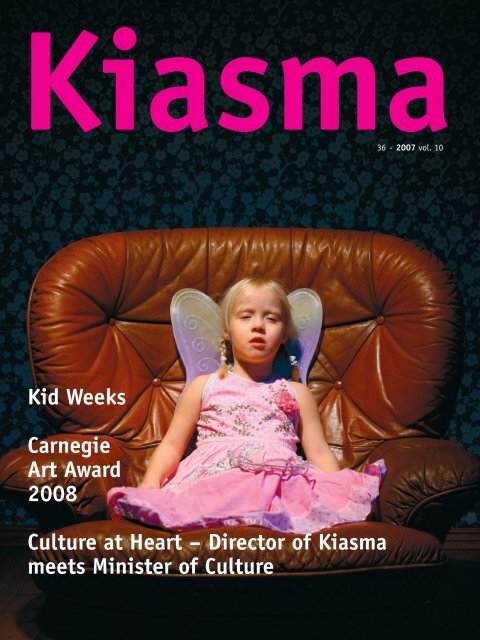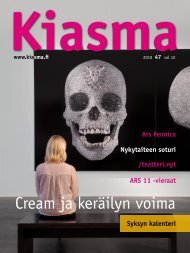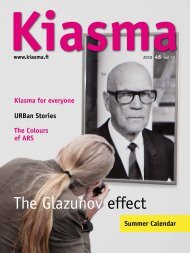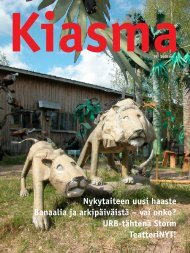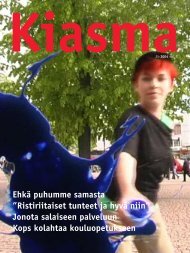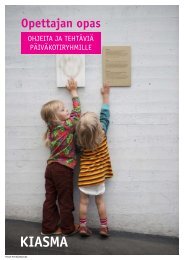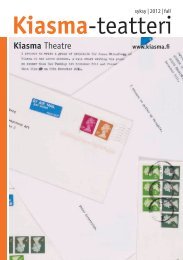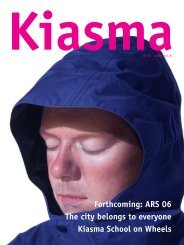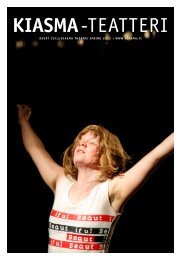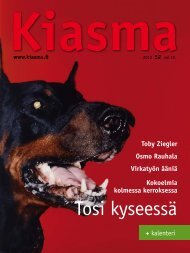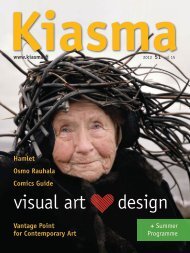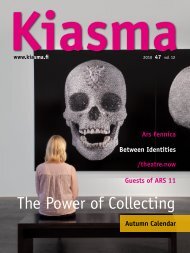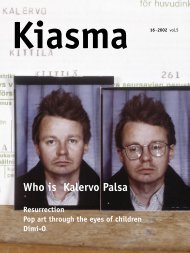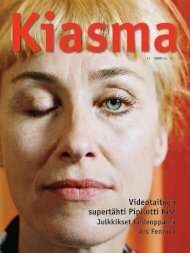Kiasma Magazine 36 PDF-version
Kiasma Magazine 36 PDF-version
Kiasma Magazine 36 PDF-version
Create successful ePaper yourself
Turn your PDF publications into a flip-book with our unique Google optimized e-Paper software.
<strong>36</strong> · 2007 vol. 10<br />
Kid Weeks<br />
Carnegie<br />
Art Award<br />
2008<br />
Culture at Heart - Director of <strong>Kiasma</strong><br />
meets Minister of Culture
<strong>Kiasma</strong>’s Director Berndt Arell<br />
challenged Stefan Wallin, Minister<br />
of Culture, to a debate on some<br />
the topical issues of the day.<br />
ANNIINA PIRTTIMAA<br />
Culture<br />
at Heart<br />
We meet in a cosy café and have a<br />
unique opportunity during a long lunch<br />
to discuss, undisturbed, certain central<br />
issues in culture, both those that our new<br />
Minister of Culture and Sports has introduced<br />
already at the start of his period of office,<br />
and also issues raised in earlier discussions.
PETRI VIRTANEN / CAA<br />
ANNIINA PIRTTIMAA<br />
“How to demonstrate that cultural experiences<br />
have a real effect as part of the quality of life,<br />
and also as an important building block of<br />
the welfare society.”<br />
Questions concerning the art sector in particular are<br />
our primary concern, and our first conversation revolves<br />
around the new culture voucher. The voucher is intended<br />
as a kind of parallel to the exercise voucher. Together<br />
with the Ministry of Finance, the Minister has appointed<br />
a working group, which in the coming autumn is expected<br />
to draw up a bill for a revision of the income tax law.<br />
The culture voucher should be ready for launch in the<br />
beginning of 2009. It is still debated where and how<br />
the voucher should be applicable, but one possibility is<br />
to make it valid in all cultural institutions that enjoy<br />
government support. This in itself is a quality control<br />
measure that should function well.<br />
Our thoughts move next to issues involving free admission,<br />
reduced admission price in the form of a culture<br />
voucher issued by employers, and what effects it can<br />
have. The Swedish example of free entry to state-run<br />
museums, which as we know was concluded in the<br />
beginning of this year, was positive. Visitor numbers<br />
increased in all museums, sometimes dramatically,<br />
and people were generally happy with the system.<br />
Free admission applied to basic museum exhibitions,<br />
but not special exhibitions. When it was withdrawn,<br />
visitor numbers dropped very quickly.<br />
The culture voucher is a refinement of the concept of<br />
free entry. The reduced admission price entails entry to<br />
permanent collections as well as special exhibitions,<br />
and would not be restricted to state-run museums. Our<br />
discussion examines such issues of principle, and Stefan<br />
Wallin wants to emphasise that it is precisely this, that<br />
the admission fee is not scrapped altogether, but that<br />
instead people are offered a voucher which in itself has<br />
a value, that can be seen as the more valuable option.<br />
The fact that the voucher could be used anywhere one<br />
likes, that it would not be limited only to museums, but<br />
would also apply to theatres, concerts, and the like,<br />
would undoubtedly bring the voucher greater added<br />
value.<br />
CULTURE BRINGS HEALTH<br />
This discussion leads us unbidden to questions about the<br />
general significance of culture in society. The Minister has<br />
obviously just come from heated budget negotiations,<br />
because we spend a great deal of time discussing issues<br />
that involve measurability, the ever-present burden of<br />
proof laid on culture: how to demonstrate that cultural<br />
experiences have a real effect as part of the quality<br />
of life, and also as an important building block of the<br />
welfare society.<br />
Stefan Wallin says that it is possible to show that<br />
the deteriorating physical condition of the population<br />
is costing the country about 400 million euro every<br />
year. Similar figures can also be cited about culture.<br />
A Swedish study undertaken at the Karolinska Institutet<br />
in Stockholm in 2001 shows that culturally active<br />
people use 57% less health-care services than people<br />
on average. I am particularly taken by the fact that it is<br />
possible to measure the effect of cultural experiences on<br />
us. The endorphin content in the body increases after<br />
art experiences, and it is clearly measurable. Wonderful,<br />
I think to myself, that’s what it has often felt like<br />
after a really good concert or art exhibition.<br />
TAX DEDUCTIONS OF DONATIONS<br />
We finish our lunchtime conversation by touching<br />
upon the situation of state-run cultural institutions.<br />
The Minister assures me that the state will also, in the<br />
future, be an active financing body committed to maintaining<br />
operations at a certain level without allowing<br />
them to flag. He sees the contributions of the business<br />
sector in this area as something exclusively positive,<br />
especially the fact that increasingly more businesses<br />
today like to be associated with culture as a natural part<br />
of their profile. The new government has taken this into<br />
special consideration by including in its new budget a<br />
proposal for increasing the tax deduction of donations<br />
to science and culture from the current 25,000 euro to<br />
250,000 euro. The minister is also working to have the<br />
deduction extended so as to cover not only businesses<br />
but private individuals as well, and that this should<br />
happen during the current election period.<br />
To conclude our conversation, I cannot resist asking<br />
Stefan Wallin about his own relationship to art, contemporary<br />
art in particular. His diplomatic answer is<br />
that he “is working on it”, while he also stresses that<br />
there are no short cuts to contemporary art. All you can<br />
do is to see as much as possible. Among the summer’s<br />
most interesting art experiences is the exhibition of<br />
Maire Gullichsen’s art collections at the Pori Art Museum,<br />
and Sigrid Juselius’s mausoleum in the same town.<br />
The strategy is to include an art exhibition in every visit<br />
to a new place. That means many endorphin-inducing<br />
experiences!<br />
Berndt Arell<br />
Director of <strong>Kiasma</strong><br />
4 <strong>Kiasma</strong>
GERRY JOHANSSON<br />
v Torsten Andersson<br />
Nathalie Djurberg:<br />
New Movements in Fashion, 2006<br />
HANS BERG<br />
The Museum of Contemporary Art, <strong>Kiasma</strong>, is hosting the<br />
opening of this year’s Carnegie Art Award Exhibition and the<br />
presentation of one of the biggest art awards in the world.<br />
The award, worth SEK 1,000,000, goes this year to the<br />
Swedish artist Torsten Andersson, known for the energetic<br />
quality of his paintings. Other recipients are Danish artists<br />
Jesper Just and John Kørner and Nathalie Djurberg from<br />
Sweden who received the young artist’s scholarship.<br />
CARNEGIE<br />
ART<br />
AWARD<br />
Carnegie Art Award 2008<br />
The biggest art award in the Nordic<br />
countries to be presented in <strong>Kiasma</strong><br />
The jury unanimously awarded the first<br />
prize to Torsten Andersson (born 1926)<br />
in recognition of his conceptual painting<br />
and energetic use of materials.<br />
Torsten Andersson’s imagery is extremely<br />
individualistic and he has developed it<br />
throughout his long artistic career.<br />
The second prize, SEK 600,000, goes to<br />
Jesper Just (born 1974) from Denmark<br />
for his film A Vicious Undertow. In its<br />
emphasis on accurate visuals the work<br />
includes many references to painting.<br />
Just has previously received a great deal<br />
of praise for his films, which have dealt<br />
with, for example, gender roles and<br />
social codes transported from Hollywood<br />
cinema.<br />
The Dane John Kørner (born 1967)<br />
receives the third prize worth SEK<br />
400,000. In his art, Kørner deals with<br />
various historical, social and political<br />
issues. The jury particularly appreciated<br />
the artist’s playful, radiant paintings, in<br />
which he reduces the figurative elements<br />
of everyday subject matter into abstract<br />
forms.<br />
The SEK 100,000 scholarship for a young<br />
artist goes to Nathalie Djurberg (born<br />
1978) for her visual narrative in the film<br />
New Movements in Fashion. Djurberg’s<br />
animations have been described as children’s<br />
films unsuitable for children.<br />
THE TOUR BEGINS IN KIASMA<br />
The awards will be presented at an<br />
official ceremony in the Museum of Contemporary<br />
Art <strong>Kiasma</strong>, in Helsinki on 25<br />
October. At the same time, the Carnegie<br />
Art Award 2008 touring exhibition will<br />
be opened. After <strong>Kiasma</strong>, the exhibition<br />
will go on tour to other Nordic capitals,<br />
Gothenburg and London. The exhibition<br />
comprises works from the 26 Nordic<br />
finalists who were chosen from among<br />
143 entrants.<br />
SIX FINNISH ARTISTS<br />
Finnish artists are represented in the<br />
exhibition by Pertti Kekarainen, Jukka<br />
Korkeila, Jussi Niva, Vesa-Pekka Rannikko,<br />
Silja Rantanen and Anna Tuori.<br />
Pertti Kekarainen received his education<br />
as a sculptor and painter at the Royal<br />
Academy of Art in The Hague. Kekarainen<br />
is interested in the relationship between<br />
colour and light, space and time, as well<br />
as two and three dimensionality and<br />
issues pertaining to them. “The content<br />
depends on which series of pictures<br />
or which combination of pictures we<br />
are talking about. Spaces, movement,<br />
expressions, atmospheres, memories<br />
… things that are like the tip of the<br />
iceberg, you can find a lot of surprising<br />
things underneath them. What you<br />
see gives rise to stories later on,” says<br />
Kekarainen in the exhibition catalogue<br />
Site 1.<br />
Internationalism and knowledge of different<br />
cultures can be perceived as being<br />
realised on a different level in the<br />
case of Jukka Korkeila. The artist, who<br />
was born in Hämeenlinna, has lived<br />
and studied in, for example, Berlin.<br />
His paintings have been exhibited in<br />
Sweden, Spain, Belgium and the United<br />
States, just to give a few examples.<br />
6 <strong>Kiasma</strong> <strong>Kiasma</strong> 7
TOVE KURTZWEIL<br />
Experience and interest in different<br />
countries and cultures is made concrete<br />
in Korkeila’s art: in his paintings he<br />
combines various visual cultures of<br />
globalised popular culture.<br />
In his works, Jussi Niva has studied and<br />
questioned the conventions of painting,<br />
in addition to which his output also<br />
includes photographs as independent<br />
works of art or as parts of paintings.<br />
Moreover, the colour scale of photography<br />
has affected his paintings. In<br />
his works, Niva has studied the absolute,<br />
context-independent characteristics<br />
of colour and space.<br />
Vesa-Pekka Rannikko has worked with<br />
video, sculpture and painting as well<br />
as performance art. He has worked on<br />
sculptures made from tinted plaster to<br />
make the feeling of light present in the<br />
sculpture itself. “These works create a<br />
paradox, where the sculpture as a threedimensional<br />
object is present in a given<br />
space and light while at the same time<br />
representing another situation, marked<br />
by the light and shadow it carries. Thus,<br />
the sculpture is simultaneously present<br />
in the past and in the present,” says<br />
the artist on his website.<br />
Anna Tuori’s paintings are expressionismflavoured<br />
works in which discordant<br />
elements appear behind the veneer of<br />
apparent idyll. Moods and memories of<br />
what she has read, seen and experienced<br />
serve as points of departure of Tuori’s<br />
works. “In my work, experience is a prerequisite<br />
of expression. I’m not attempting<br />
to repeat an experience in my works<br />
in a straightforward manner, or relate<br />
what has happened to me, but to share<br />
and bring out, for example, issues that<br />
have arisen in my mind.”<br />
The subject matter of Silja Rantanen’s<br />
paintings are closely associated with the<br />
meaning of space and experience as well<br />
as the various ways of expressing those<br />
concepts in painting. Both the worlds of<br />
art and everyday reality are powerfully<br />
present in the Helsinki-based artist’s<br />
paintings. According to Rantanen, art is<br />
always based on the personal experience<br />
of the artist, which, however, can be<br />
focused on general or conceptual issues.<br />
“This is something that audiences nowadays<br />
have a hard time dealing with in<br />
contemporary art: that someone with all<br />
her might would want to build a model<br />
of, say, the greenhouse effect.”<br />
Further information: Carnagie Art<br />
Award 2008 catalogue or www.kiasma.fi<br />
Nathalie Djurberg<br />
Scholarship for a young artist<br />
What does it mean for you to<br />
make art?<br />
Art is my only form of expression in<br />
which I am completely honest.<br />
What do you consider to be the<br />
most important way of expression<br />
or material for you?<br />
Whatever means necessary.<br />
Who or what has had the biggest<br />
influence on your art?<br />
Myself and certain literature, but of<br />
other art I’m very influenced by the<br />
Chapman brothers and Goya.<br />
Does art have to be based on<br />
the artist’s personal experience?<br />
No.<br />
Is there some element that<br />
unites Nordic contemporary art?<br />
Yes I believe so; I think it’s<br />
impossible to ignore the fact that<br />
we share a similar cultural background.<br />
By this I do not mean that<br />
the art looks the same but that we<br />
perhaps approach questions and<br />
problems in a similar fashion.<br />
John Kørner: 1st Floor Museum, 2007<br />
Do we have contemporary Nordic art?<br />
The aim of the Carnegie<br />
Art Award Exhibition is to<br />
promote and support contemporary<br />
Nordic art and<br />
artists. But are there any<br />
features that the exhibited<br />
works share? Are there some<br />
characteristics common to<br />
contemporary Nordic art?<br />
We asked the artists in the<br />
exhibition about their views<br />
on the matter.<br />
Anna Tuori (Finland): “I think there is,<br />
but it’s difficult to say what it is. Maybe<br />
a certain kind of straightforwardness.<br />
The weight of tradition does not hinder<br />
art in the Nordic countries to the same<br />
degree that it does in many of the Meccas<br />
of older art. On the other hand, there is<br />
not as clearly branded an arts identity as,<br />
for example, the East German retro boom<br />
that followed after Abstract Expressionism<br />
in Germany or the intellectual cool<br />
still prevalent in the arts in England.<br />
Else Marie Hagen (Norway): “Even<br />
though it is possible to look for and<br />
find elements that might be typical of<br />
contemporary Nordic art, such as the<br />
closeness of people with nature or the<br />
worry over one’s own culture arising in<br />
sparsely populated areas, there are other<br />
factors affecting the decision over which<br />
elements will be displayed.<br />
Artists and art movements that come<br />
to the fore in any given era are largely<br />
dependent on the kind of atmosphere<br />
that prevails among the most influential<br />
members and institutions in the field of<br />
arts. This means that the question of the<br />
typical features of contemporary Nordic<br />
art might, for example, depend on<br />
whether Nordic countries are perceived<br />
as the backwater of the international<br />
scene or part of it.<br />
8 <strong>Kiasma</strong> <strong>Kiasma</strong> 9
Personally, I don’t find it important to<br />
identify with any particularly Nordic<br />
identity or fit in with any particular<br />
international trend. Even if I was in<br />
possession of some comprehensive view<br />
that would allow me to say something<br />
about the prevalent features of Nordic<br />
art, I assume it would still be complex<br />
in nature. Complexity is an advantage<br />
because it allows artists to participate<br />
in different contexts and forge new<br />
relationships.”<br />
Fie Norsker (Denmark): “If I had to<br />
choose just one common element it<br />
would probably be interest in art outside<br />
the Nordic countries.”<br />
Karin Wikström (Sweden): “I don’t<br />
know really. In many ways it’s difficult<br />
to see what would be particularly Nordic<br />
nowadays in a world where people are<br />
trying hard to be global. In some sense,<br />
the idea of a certain field of contemporary<br />
Nordic art is somewhat anachronistic.<br />
On the other hand, we still are, of<br />
course, part of a Nordic context. Many<br />
of us artists live and work here and it is<br />
bound to have some effect on the art.<br />
But what those elements are, I really<br />
can’t say for sure.”<br />
Jesper Just: A Vicious Undertow, 200t<br />
Torsten Andersson: Blood-Coloured Flow<br />
- Personality as Person, 2006<br />
Silja Rantanen (Finland): “Contemporary<br />
Nordic art is art made by Nordic artists.<br />
They are connected by their background:<br />
Nordic countries are sparsely populated,<br />
they are representative democracies, which<br />
work in such a self-evident manner that<br />
the citizens have stopped appreciating<br />
politics, and they all have a high standard<br />
of living. Almost everyone can read. The<br />
countries have historical and geopolitical<br />
differences but these have a negligible<br />
impact on contemporary art. All of this<br />
has, of course, formed the artists who have<br />
been raised in this culture. A caring<br />
atmosphere tends to encourage individuals<br />
to believe in their rights but I<br />
don’t see any signs of it in the art itself.<br />
Sweeping interpretative generalisations<br />
are dangerous. Even in art, they often<br />
lead to abuse. The viewer is no longer<br />
capable of looking at individual works<br />
but begins by adapting ready-made<br />
interpretative models.”<br />
Thordis Aðalsteinsdóttir (Iceland):<br />
“Not that I know of.”<br />
Thór Vigfússon (Iceland): “Probably.”<br />
Tor-Magnus Lundeby (Norway): “I<br />
would guess the general Nordic temper<br />
affects the art too in the way the story<br />
is told or presented. One doesn’t eventually<br />
need to speak out loud, if one is<br />
listening to each other. I mean maybe<br />
it depends on whether Nordic art is presented<br />
or made site specific in for example<br />
Southern Europe or up North.”<br />
Jens Fänge (Sweden): “No, there isn’t<br />
any.”<br />
Julia Kristensen<br />
/theatre.now! 10.–21 Oct . Reality Research Centre / Pilvi Porkola: LURE – Performance about new work PHOTO Pilvi Porkola (detail)<br />
<strong>Kiasma</strong> Calendar<br />
10 <strong>Kiasma</strong>
EXHIBITIONS<br />
PROJECTS AT KIASMA<br />
KIASMA THEATRE<br />
TOVE KURTZWEIL<br />
Time of the Storytellers<br />
Narrative and Distant gaze<br />
in Post-Soviet Art<br />
Until 30 September, 4th and 5th floors<br />
Carnegie Art Award<br />
26 October–6 January, 4th and 5th floors<br />
The Carnegie Art Award is both an exhibition<br />
and an art award whose aim is to promote and<br />
support contemporary Nordic art and artists.<br />
This year the touring exhibition starts off from<br />
<strong>Kiasma</strong> and it gathers together 26 artists.<br />
The winner of the Carnegie Art Award 2008 is<br />
Swedish artist Torsten Anderson.<br />
The exhibition artists: Thordis Aðalsteinsdóttir<br />
(IS), Torsten Andersson (SE), Nathalie Djurberg<br />
(SE), Gardar Eide Einarsson (NO), Anette H. Flensburg<br />
(DK), Jens Fänge (SE), Else Marie Hagen (NO),<br />
Ellen Hyllemose (DK), Jarl Ingvarsson (SE), Kristina<br />
Jansson (SE), Jesper Just (DK), Pertti Kekarainen<br />
(FIN), Jukka Korkeila (FIN), Ferdinand Ahm Krag<br />
(DK), John Kørner (DK), Tor-Magnus Lundeby (NO),<br />
Jussi Niva (FIN), Fie Norsker (DK), Allan Otte (DK),<br />
Vesa-Pekka Rannikko (FIN), Silja Rantanen (FIN),<br />
Kirstine Roepstorff (DK), Thorbjørn Sørensen (NO),<br />
Anna Tuori (FIN), Thór Vigfússon (IS), Karin<br />
Wikström (SE).<br />
A Carnegie Contact Guide will be available<br />
Wed 10am-3pm, Thu 2-7pm, Fre 5-8pm and<br />
Sun 11am-2pm.<br />
The Raw, the Cooked, the Packaged<br />
– The Archieve of Perestroika Art<br />
16 November–6 January 2008, Studio K<br />
Works of art, photographs, sketches, manifestos,<br />
official documents, posters and fliers form a whole,<br />
which brings artists’ personal perspectives to<br />
that historically perestroika era Soviet Union.<br />
When the Heavens Fell... remake<br />
Maija Blåfield and Anu Suhonen<br />
12 Oct 2007–6 Jan 2008, Kontti<br />
The video work is a reinterpretation of Risto<br />
Jarva’s 1972 film When the Heavens Fell, which<br />
was a story about a scandal involving a press<br />
reporter and his victim.<br />
COLLECTIONS<br />
Landscape in <strong>Kiasma</strong>’s<br />
Collections<br />
Until 4 November, 2nd and 3rd floors<br />
Landscape is one of the most beloved subjects<br />
in fine arts. <strong>Kiasma</strong>’s Landscape collection<br />
exhibition presents contemporary artists’ takes<br />
on the subject. In addition, the website of the<br />
Finnish National Gallery provides basic information<br />
on works and artists in its collections.<br />
You can acquaint yourself with <strong>Kiasma</strong>’s collections<br />
at www.kiasma.fi<br />
Evil Eye<br />
28 September–4 November, Studio K<br />
Humberto Junca’s, Tuomas Laitinen’s, Liisa<br />
Lounila’s and Kim Simonsson’s works from<br />
<strong>Kiasma</strong>’s collections.<br />
<strong>Kiasma</strong>’s Kid Weeks 2–12 October<br />
Workshops and activities for under four-yearolds<br />
and accompanying adults.<br />
Babies Play with Colour workshops are a place<br />
for 3- to 12-month-old babies to acquaint themselves<br />
with the world of colours and materials.<br />
Advance registration.<br />
Kid Tour presents the Landscape exhibition<br />
to children and their parents from the child’s<br />
perspective. Adults museum admission.<br />
Tue–Sat 2–6 October, 11–12 noon.<br />
Tue–Fri 9–5 October, 3–4 pm.<br />
John Kørner: Birds in the Yellow Gallery, 2007 . Maija Blåfield and Anu Suhonen: When Heaven Fell... remake . Marte Aas: Like a Forest, 2003 . Kid Weeks<br />
KEVIN REGAN / CAA<br />
In the Drop-in Extra Small’s workshop toddlers<br />
and adults can examine and work together on<br />
assignments pertaining to the Landscape<br />
exhibition. Adults museum admission.<br />
Tue–Fri 9–12 October, 10 am–1 pm, 2–5 pm.<br />
Expert lectures for adults provide information<br />
about the stages of children’s early development.<br />
Seminar room. Free admission. In Finnish.<br />
Tue 2 Octr 3–4.30 pm & Wed 10 Oct 5–6.30 pm<br />
Researcher, MA (Psychology) Niina Komsi:<br />
Babies have their own personalities and a<br />
unique way of encountering the world.<br />
Wed 3 Oct 3–4.30 pm & Fri 5 Oct 5–6.30 pm<br />
Brain researcher, Adjunct Professor Minna<br />
Huotilainen: How babies learn about what they<br />
see and experience.<br />
Kid Sunday activity day 7 October 10am-5pm<br />
programme for the whole family on children’s<br />
terms. Extra small’s workshops, Kid Tours and<br />
story-composing workshops. A Kid route built<br />
on <strong>Kiasma</strong>’s 4th is particularly for 1- to 3-yearold<br />
toddlers. Free entry.<br />
Home for Christmas<br />
The workshop, organised in November, is aimed<br />
at young people with a multicultural<br />
background. Part of a Home for Christmas<br />
project of the Finnish National Gallery.<br />
Further information: elina.katara@kiasma.fi.<br />
Free admission.<br />
HEIDI ELOMAA<br />
Oblivia<br />
Everything You Say Will Become Dust Anyway<br />
Premiere Thu 23 August 7 pm, <strong>Kiasma</strong> Theatre<br />
The group typically utilises conceptualisation,<br />
minimalism and comedy. In English.<br />
Performances: 28 Aug at 3 pm, 26 and 30 Aug<br />
at 7 pm, 1 Sep at 3 pm and 5 Sep at 7 pm.<br />
Tickets EUR 12/8 www.oblivia.fi<br />
Circus Maximus<br />
The Best in the World – “the Virtual”<br />
and “cyborgs” in developed capitalism<br />
Premiere Wed 19 Sep, <strong>Kiasma</strong> Theatre<br />
The performance deals with a manifestation of<br />
capitalism: gambling addiction, the act of gaming<br />
and beating others at it. Other performances:<br />
21, 22, 23, 26, 27, 28 and 30 September at 7<br />
pm. Audience discussion on 26 Sep, after the<br />
performance. Tickets EUR 12/8<br />
/theatre.now<br />
10–21 Oct<br />
Reality Research Centre<br />
Politics of Silence – a bodily installation<br />
Premiere Wed 10 October, <strong>Kiasma</strong> 3rd floor<br />
The topic is people’s experiences of silence.<br />
Part of the Reality Research Centres research<br />
plan, the theme of which is social issues and<br />
art. Performances: 11 and 12 Oct at 6 pm and<br />
13 Oct at 1 pm. Tickets EUR 12/8<br />
Sanna Kekäläinen: Puna-Red-Rouge<br />
Wed 10 Oct at 7pm, <strong>Kiasma</strong> Theatre<br />
In Sanna Kekäläinen’s solo piece the colour<br />
red is a metaphor for both the private and<br />
subjective as well as the provocatively public.<br />
The work had its premiere in the <strong>Kiasma</strong><br />
Theatre in spring 2007. Tickets EUR 12/8<br />
Rude Mechanicals: Get Your War On<br />
Premiere Thu 11 Oct at 7 pm, Espoo City Theatre<br />
/ Louhisali / Espoo Cultural Centre<br />
The Texan theatre group has created a political<br />
satire based on the comic series by David Rees,<br />
in which white-collar office workers try to grasp<br />
the post-9/11 America. Performances: 12 Oct at<br />
7 pm and 13 Oct at 3 pm. Tickets EUR 25/21/15.<br />
www.espoonteatteri.fi www.rudemechs.com<br />
Reality Research Centre / Pilvi Porkola<br />
LURE – Performance about new work<br />
Premiere Wed 12 Oct at 7 pm<br />
LURE is an art exhibition comprising imaginary<br />
works. The performance was premiered in spring<br />
2007 at The Story of Work festival in Copenhagen.<br />
Performances: 14, 16, 18, 19, 20, 23, 24,<br />
25, 26 and 27 Oct at 7 pm. Tickets EUR 12/8.<br />
www.todellisuus.fi<br />
Martin Bélanger: Spoken Word/Body<br />
Premiere Wed 31 Oct at 7 pm, <strong>Kiasma</strong> Theatre<br />
Martin Bélanger pays tribute to the American<br />
tradition of the spoken word, a musical form in<br />
which poems and stories are recited and spoken.<br />
Spoken Word combines autobiographical material<br />
with social, political and poetic narration.<br />
Part of the Moving in November festival.<br />
Performances: 1 Nov at 7 pm. Tickets EUR 17/10.<br />
Avanto Festival 16–18 Nov, <strong>Kiasma</strong> Theatre<br />
Festival will focus on experimental cinema<br />
under the heading “International Free Cinema”.<br />
The main guests are Michael Snow and Peter<br />
Kubelka. The festival also features Douglas<br />
Gordon’s newest work Zidane: A 21st Century<br />
Portrait, and a series of experimental 21st<br />
century Russian films curated by Masha Godovannaya<br />
from St Petersburg. The Avantoscope<br />
series presents an overview of the new experimental<br />
film. The tickets sales will begin on<br />
1 November. www.avantofestival.com.<br />
Demo Market Sat 13 November at 2 pm<br />
Unfinished performances, unrealised ideas, gaps<br />
and fringes in <strong>Kiasma</strong>’s lobby and in the <strong>Kiasma</strong><br />
Theatre. The duration of the demos is max. 20<br />
minutes. Tickets EUR 6/4.<br />
Nora Lähteenmäki: FAMILY ALBUM:<br />
Securing the Shadow (live installation)<br />
Mediateekki, <strong>Kiasma</strong>’s 2nd Floor<br />
Performances: Oct 13 at 1 pm, Oct 17 at 6 pm,<br />
Oct 19 at 6 pm, Oct 20 at 6 pm Installation:<br />
museum’s opening hours. Installation that<br />
combines photography, video, live performance<br />
and music. Museum tickets EUR 12/8.<br />
Venus Theatre: Dirty stories<br />
Premiere Tue 16 Oct, <strong>Kiasma</strong> Seminar room<br />
Dirty Stories takes an in-depth look at the city<br />
centre, the polished consumer environment,<br />
imitating actions that in that environment<br />
turn into rubbish, dirty and forbidden acts.<br />
The Venus theatre is a Helsinki-based group<br />
established in 1983. Performances: 18 and 19<br />
Oct at 6 pm, 20 and 21 Oct at 5 pm.<br />
Tickets EUR 12/8. www.universum.fi/venus<br />
Maus & Orlovski: Mr Nilsson – I Memo of Time<br />
Tue 16 Oct at 7 pm, The Finnish National<br />
Theatre, Omapohja<br />
Mr Nilsson – I Memo of Time addresses the<br />
relationship of humans to other animals and<br />
nature. The performance premiered in the<br />
<strong>Kiasma</strong> Theatre in autumn 2006. The new<br />
<strong>version</strong> to be seen is the English-language<br />
touring <strong>version</strong>. Tickets EUR 20/10.<br />
www.nationaltheatre.fi<br />
DemoKino: Baltic Circle<br />
Premiere Wed 21 Nov at 7 pm, Seminar room<br />
DemoKino is a virtual biopolitical parliament<br />
the format of which resembles democratic<br />
decision making. Eight short films portraying<br />
a young man’s everyday life in his own home.<br />
At the end of each film, the audience can vote<br />
either in favour of or against the issue.<br />
Performances: 22 and 23 Nov at 7 pm, 24 Nov<br />
at 3 pm. Tickets EUR 6/4.<br />
www.q-teatteri.fi /baltic_circle<br />
Nälkäteatteri (Hunger Theatre): Odradek<br />
Premiere Wed 28 Nov at 7 pm, <strong>Kiasma</strong> Theatre<br />
In the interactive performance by the In Alternate<br />
Spaces project Odradek from Kafka’s short<br />
story “Cares of a Family Man” is a chameleon,<br />
a creature constantly changing shape, a metamorphosis<br />
towards the unknown. Performances:<br />
30 Nov at 7 pm, 2 Dec at 3 pm, 5 Dec at 7 pm<br />
and 7 Dec at 7 pm. Tickets EUR 12/8.<br />
www.toisissatiloissa.net<br />
/theatre.now festival offers a new vision or perspective on performance art. This year the<br />
programme includes international visits and new openings on the fringes of institutional theatre.<br />
PONI<br />
Project 2: Soma Sema<br />
Wed 17 Oct at 7 pm, <strong>Kiasma</strong> Theatre<br />
The Brussels-based collective PONI’s Project 2<br />
(2006) turns its sights on theatre. The key words<br />
of the Soma Sema performance are Ritual,<br />
Illusion and Death. The question is how to<br />
dismantle the rituals and obsessions of theatre.<br />
Tickets EUR 12/8. www.poni.be<br />
Kate McIntosh: All Natural<br />
Fri 19 Oct at 7pm, <strong>Kiasma</strong> Theatre<br />
The performance deals with the myth of “naturalness”<br />
and our craving for it. Kate McIntosh is<br />
a dancer and choreographer from New Zealand,<br />
who has for the last six years lived and worked<br />
in Brussels. Tickets EUR 12/8.<br />
www.margaritaproduction.be<br />
Ulos kaapista (“Out of the Closet”)<br />
Sat 20 Oct at 2–7pm, <strong>Kiasma</strong> Theatre<br />
The video series from <strong>Kiasma</strong> Collections features<br />
gems of video art and short film, seldom seen<br />
on the big screen. Tickets EUR 6/4.<br />
Parallax writing workshop<br />
Writing laboratory Parallax directs its gaze<br />
at /theatre.now events. Further information<br />
maijahirvanen@yahoo.com.
LECTURES<br />
WORKSHOP<br />
PETRI VIRTANEN / CAA<br />
Philosophy of the gaze: Free art, power<br />
and powerlessness<br />
Wednesdays and Thursdays at 5 pm.<br />
Seminar room. In Finnish. Free admission.<br />
In co-operation with the Critical Academy.<br />
12 Sep Claes Andersson, MP<br />
13 Sep Markus Konttinen, painter<br />
20 Sep Raija-Leena Loisa, Doctor of Social<br />
Sciences, Researcher<br />
26 Sep Power relationships in fine arts in<br />
a state of flux, panel discussion chaired by<br />
Berndt Arell, Director of <strong>Kiasma</strong>, Jan Kaila,<br />
artist, Professor, Reetta Meriläinen, Editorin-Chief<br />
Helsingin Sanomat, and Petri Tuomi-<br />
Nikula, Director General of the Dept. of<br />
Communication and Culture, Finnish Foreign<br />
Ministry.<br />
4 Oct Radoslaw Gryta, sculptor<br />
GUIDED TOURS<br />
Guided tours<br />
The Landscape collection display on Fridays<br />
at 6 pm. Free admission. In Finnish.<br />
Expert tours and guided tours to changing<br />
exhibitions on Wednesdays at 6 pm. Museum<br />
admission. In Finnish.<br />
The changing exhibitions also on Sundays<br />
at 3 pm. Museum admission. In Finnish.<br />
Guided tours in Swedish are held on the first<br />
Sunday of each month at noon. Museum<br />
admission.<br />
Tour bookings<br />
Tours can be individually tailored to groups.<br />
Tour bookings Mon–Fri 9 am–12 noon tel.<br />
+358 (0)9 1733 6509. Prices on weekdays EUR<br />
60, Sundays EUR€75. Tour languages available<br />
are English, Finnish, French, German, Russian<br />
and Swedish.<br />
Landscape audio guide<br />
The audio guide provides background<br />
information and different ways of interpretation<br />
to the Landscape collection display.<br />
Fee EUR€2. Download the audio guide to your<br />
MP3 player free of charge at www.kiasma.fi.<br />
In Finnish, Swedish and English.<br />
Expert tours<br />
Experts from various fields will guide the<br />
audience through exhibitions on Wednesdays<br />
at 6 pm. If there is no visiting expert, a guided<br />
tour of the changing exhibition will its place.<br />
The Museum Director of <strong>Kiasma</strong>, Berndt Arell<br />
guides the audiences on three Wednesdays at<br />
6 pm. 5 Sep in Finnish, 7 Nov in Swedish, 21<br />
Nov in Finnish. Museum admission. Further<br />
information, www.kiasma.fi<br />
Let’s do it together! (adults and children<br />
together) Saturdays at 10.30 am–1 pm and<br />
2.30–4.30 pm. The activities are inspired by<br />
<strong>Kiasma</strong>’s exhibitions. In Finnish.<br />
8 Sep Heroic tales – building a miniature world<br />
15 Sep Forgotten time – graphics<br />
22 Sep Identifying colour – building and<br />
painting<br />
29 Sep Dreams – a story about me – watercolour<br />
and collage<br />
13 Oct The Earth – painting<br />
20 Oct Curious wanderers – making clothing<br />
27 Oct From the mould – moulding characters<br />
3 Nov Camouflage – camouflaging as a part of<br />
a work of art<br />
10 Nov In mechanical landscapes – building<br />
out of scrap<br />
17 Nov Coloured dreams – letterpress graphics<br />
24 Nov Invisible city – collage<br />
1 Dec Secret – crayon drawing<br />
8 Dec Carnival – watercolour painting<br />
Registration for the morning workshop Mon-Fri<br />
9 am–12 noon, tel. +358 9 1733 6509. Under<br />
18-year-olds free, adults EUR 6/4.<br />
No registration in advance for the afternoon<br />
non-stop workshop. Under 18-year-olds free,<br />
adults EUR 6/4.<br />
With friends, for adults<br />
With friends is a workshop aimed at groups of<br />
workmates and clubs, in which participants<br />
get acquainted with contemporary art through<br />
hands-on artistic work. The workshop includes<br />
an exhibition visit and instruction by the<br />
guide. The workshops are organised on Fridays.<br />
Group size: 10–15 people; duration: 3 h; fee €<br />
13 per person (includes admission, materials<br />
and instruction). Inquiries/bookings tel.<br />
+358 (0)9 1733 6521.<br />
FOR SCHOOLS AND KINDERGARTENS<br />
For more information in Finnish see:<br />
www.kiasma.fi/kouluille<br />
INFO<br />
<strong>Kiasma</strong><br />
Mannerheiminaukio 2, 00100 Helsinki<br />
Info +358 (0)9 1733 6501, info@kiasma.fi<br />
<strong>Kiasma</strong> is open<br />
Tue 10 am–5 pm,<br />
Wed–Sun 10 am–8.30 pm<br />
Tickets EUR 6/4, free for under 18-yearolds.<br />
Fridays 5–8 pm free admission.<br />
<strong>Kiasma</strong> is fully accessible. Guide dogs are<br />
welcome. The ticket office and the Theatre<br />
are equipped with tele/induction loop<br />
systems.<br />
Museum of Contemporary Art <strong>Kiasma</strong><br />
is part of the Finnish National Gallery.<br />
<strong>Kiasma</strong> Store is open<br />
Tue 10 am–5 pm, Wed–Sun 11 am–7 pm,<br />
tel. +358 (0)9 1733 6505.<br />
Café <strong>Kiasma</strong> is open<br />
Tue 10 am–5 pm, Wed–Sun 10 am–9 pm,<br />
tel. +358 (0)9 1733 6661.<br />
Friends of <strong>Kiasma</strong><br />
Further information about Friends of<br />
<strong>Kiasma</strong> activities tel. +358 (0)9 1733<br />
6595.<br />
Information subject to change.<br />
PETRI VIRATNEN / KKA<br />
Tule ystäväksi<br />
Be a Friend<br />
<strong>Kiasma</strong>n Ystävät ry | Friends of <strong>Kiasma</strong> www.kiasma.fi<br />
Nyt etsitään seuraavaa suurta suomalaista viihdyttäjää!<br />
Laji on vapaa ja kaikki voivat osallistua.<br />
Oletko sinä vuoden 2007 huikein kotimainen kyky?<br />
Nelonen.fi/Talent
Browse, search and find<br />
The Art Collections<br />
33 000<br />
works 14 600<br />
images<br />
6 000<br />
artists<br />
<strong>Kiasma</strong><br />
for You<br />
Palsa, Kalervo<br />
painter<br />
b. 12.3.1947 Kittilä<br />
d. 3.10.1987 Kittilä<br />
COLLAGE JUSTUS HYVÄRINEN<br />
The Collections web service provides basic information<br />
on the works and artists represented in the collections<br />
of the Finnish National Gallery.<br />
You can search for information according to subject, keyword,<br />
date, main category or art form, with an open search according<br />
to artist or work names, or by using the search form. Or find your<br />
own path. You can for example follow the path from Kalervo Palsa to Nina Roos.<br />
1 515 images<br />
3 034 works<br />
Kalervo Palsa Former Director, 1969<br />
Iconclass: face (54), eyes (21), Pain,<br />
Sorrow, Sadness; ‘Dolore’, ‘Dolore di<br />
Zeusi’ (Ripa) (40), teeth (5), director,<br />
boss (in modern industry) (1), past (5)<br />
Roos, Nina<br />
Fantasy of Escape from Rotation, 2000<br />
oil on acrylic board<br />
depth 0,8 cm, height 190 cm, width 220,5 cm<br />
purchased 2001 08 29, N-2001-44<br />
Theme: Face 5/54<br />
*Iconclass is an international subject specific<br />
classification system for artworks.<br />
Iconclass:<br />
rotating, twisting (movement of the human body)<br />
(1), face (54), sight, looking (one of the five<br />
senses) (59), mind, spirit (4), Fantasy, Caprice;<br />
‘Capriccio’ (Ripa) (12), surrealia, surrealistic<br />
representations (24), Unlimited Space (2), back<br />
view (4), Motion (27), Unclarity, Imprecision (2),<br />
camera ~ photography<br />
Lucander, Robert<br />
B.K.,<br />
1995<br />
Oskar, Jon<br />
Beneath The Ornament,<br />
1989<br />
Palsa, Kalervo<br />
Former Director,<br />
1969<br />
Roos, Nina<br />
Fantasy of Escape from<br />
Rotation, 2000<br />
Hyttinen, Niilo<br />
Controlled Structural<br />
Change, 1988
PONI<br />
Project 2: Soma Sema<br />
LUC MASSIN/SUBJACTIVE<br />
On the Margins of Theatre<br />
/theatre.now is a lively festival that offers a new vision or new perspectives<br />
on the performing arts. The event emphasises the creation of social context:<br />
the coming together of people and interaction are at the core of the programme.<br />
Various performance encounters,<br />
discussions and demonstrations are an<br />
integral part of /theatre.now’s programme.<br />
The new cooperation partners of the<br />
festival, the Espoo City Theatre and the<br />
Finnish National Theatre, open up an<br />
avenue to institutional theatres and<br />
the Finnish theatre world.<br />
Kate McIntosh: All Natural<br />
KATE MCINTOSH<br />
An impressive array of Finnish theatre<br />
professionals has been involved in<br />
creating the programme, whose ideas<br />
and discussions will provide the basis for<br />
this year’s event as well. The festival is<br />
an open zone for different encounters:<br />
instead of imposing different definitions<br />
or limits, the festival collects makers,<br />
seers, talkers and debaters to performances,<br />
panel discussions and informal<br />
meetings. /theatre.now reflects the<br />
change in the field of art, which has<br />
resulted in more active and dynamic<br />
participation by artists and other people<br />
in the field.<br />
The Belgian collective PONI questions<br />
the various definitions of theatre. In<br />
their performance Soma Sema, they<br />
ask how to dismantle the rituals and<br />
conventions of theatre. And what is the<br />
illusion to which we cling, at all costs?<br />
PONI challenges hybrid theatre comprising<br />
performance, live music, dance<br />
and theatre to a furious duel.<br />
STARTING POINT REALITY<br />
Even though individual performances<br />
vary stylistically, they all have something<br />
in common. Many of the performances<br />
examine the relationship of theatre,<br />
performing and text to reality. How is<br />
the reality concretely, politically and<br />
socially present?<br />
The Reality Research Centre will present<br />
two performances at this year’s festival.<br />
The Politics of Silence examines the<br />
possibility or impossibility of silence in<br />
society. Pilvi Porkola’s LURE is an art<br />
exhibition comprising imaginary works<br />
of art. The subject matter covered by the<br />
work includes the transformation of work<br />
and working life.<br />
The festival programme contains many<br />
performances that have taken as their<br />
starting point documents, real conversations,<br />
minutes and speeches. They are<br />
used for creating historical and social<br />
parallels, glimpses of the past and an<br />
understanding of the present.<br />
Sanna Kekäläinen’s solo dance piece<br />
Puna-Red-Rouge is based on her own<br />
texts about her personal memories which<br />
are expanded to cover the general and<br />
recent history. The performance by the<br />
Texan Rude Mechanicals theatre group<br />
is a political satire based on comics by<br />
David Reese. It is a funny and sarcastic<br />
portrayal of today’s key political questions,<br />
such as the George W. Bush administration<br />
and the War on Terror.<br />
ANIMAL AND HUMAN<br />
One of the festival’s international<br />
guests is the dancer-choreographer Kate<br />
McIntosh from New Zealand, who in her<br />
piece All Natural examines the quest for<br />
naturalness and the myth surrounding it.<br />
Also Maus & Orlovski group’s Mr Nilsson<br />
addresses the relationship of humans<br />
to other animals and nature. The<br />
performance, written and directed by<br />
Tuija Kokkonen, was first premiered at<br />
the <strong>Kiasma</strong> Theatre in the autumn of<br />
2006, and is now performed in an<br />
English-language <strong>version</strong>.<br />
Dirty Stories by the Venus Theatre<br />
scratches at the relationship between<br />
repulsion and morals while tracking<br />
down actions, which turn into dirty and<br />
forbidden acts in the polished urban<br />
consumer environment. At the same time,<br />
questions emerge about connections<br />
between aestheticisation and ethics<br />
as well as aestheticisation and the<br />
performing arts.<br />
REVEALING THE PROCESS<br />
/theatre.now does not merely present<br />
things but also reveals the processes<br />
of making art. The Demo Market is a<br />
one-day event, providing artists with an<br />
opportunity to bring their work-in-progress,<br />
ideas, and process or performance<br />
demonstrations to a public forum.<br />
The writing workshop Parallax observes<br />
the events of /theatre.now, noting down<br />
the conversations and preparing texts<br />
from the performances. The participants<br />
represent a variety of viewpoints and<br />
philosophies.<br />
Virve Sutinen<br />
18 <strong>Kiasma</strong> <strong>Kiasma</strong> 19
Korkealta näkee<br />
kokonaisvaltaisesti kauemmas<br />
Haasteet on tehty<br />
ylitettäviksi yhdessä<br />
How to get everything<br />
without doing anything?<br />
The <strong>Kiasma</strong> Theatre has been a venue for all kinds of<br />
circus acts over the years. In September, Circus Maximus<br />
celebrating the premiere of its The Best in the World introduces<br />
yet another new definition of circus. The director<br />
Mikko Kanninen took some time to answer the questions.<br />
Porkkalankatu 24<br />
PL 122, 00181 Helsinki<br />
Puh: +358 (0)20 755 500<br />
Fax: +358 (0)20 755 501<br />
www.deloitte.fi<br />
© 2007 Deloitte & Touche Oy, Group of Companies. All Rights Reserved.<br />
Circus Maximus does not really have<br />
a great deal to do with traditional<br />
circus, now does it – so why the<br />
name?<br />
Circus Maximus was founded by four<br />
drama students in the student association<br />
of the Department of Acting at<br />
Tampere University. At the time, there<br />
was an article in the University magazine<br />
comparing – rather loosely and<br />
even facilely – the similarities between<br />
the hegemonies formed by the Roman<br />
Empire and contemporary Western<br />
countries, which included dichotomies<br />
such as slaves and technology, and<br />
circus and entertainment. The point was<br />
that Rome was destroyed even though it<br />
saw itself as eternal. The destruction was<br />
not a big bang or a collapse but rather a<br />
slow decay. Likewise, the Western cultural<br />
hegemony has been destroyed or is<br />
about to be destroyed because of its own<br />
infeasibility. The Circus Maximus hippodrome<br />
was one of the last “great” projects<br />
of the Roman Empire. The Circus Maximus<br />
theatre aims to be the “greatest show”<br />
in the time of our apocalypse.<br />
The Best in the World talks of the<br />
“Las Vegasation” of the world. What<br />
is the term all about?<br />
“Las Vegasation” is a term used by<br />
many, primarily American, thinkers to<br />
widely demarcate different ideological<br />
currents, the form of which is the same,<br />
present in contemporary societies.<br />
Mainly it refers to the general zeitgeist<br />
and the question of how to get everything<br />
without having to do anything. It<br />
is equally about the values of companies<br />
being changed into mere default values,<br />
the Pop Idol competition as a selection<br />
process for musicians, “Who wants to be a<br />
film star” reality shows as actor training,<br />
the poker boom, a diminishing appreciation<br />
of education and refinement, politics<br />
turning into a Pop Idol competition – that<br />
is, the overall increase in focus on entertainment<br />
in society and its concurrent<br />
transformation into a “Las Vegas”. In the<br />
background there is the realisation of the<br />
capitalist dream; everything is quantifiable<br />
nowadays, up for gambling and<br />
buying.<br />
One of the main themes of the<br />
performance is gambling addiction.<br />
What does it refer to?<br />
For example, business life, trade,<br />
chemistry, religion, the art world politics,<br />
relationships … and, of course, gambling.<br />
The subheading of the show contains<br />
the words virtual and cyborg. What do<br />
they refer to?<br />
Las Vegas is virtual, a pure virtual manifestation<br />
of the idea of America. If you<br />
want to virtually experience America in a<br />
day, you should fly to Las Vegas! There,<br />
cyborgs are attached to gambling tables<br />
and machines and even deeper are at one<br />
in the very core of machine and an idea.<br />
Usually these two terms have a very<br />
negative and desolate ring. We are<br />
trying to examine the revolutionary,<br />
positive and life-affirming qualities of<br />
the virtual and cybernetics.<br />
How would you describe The Best in<br />
the World in the context of performing<br />
arts, is it traditional theatre or<br />
something else?<br />
It is theatre if the art form is perceived<br />
as a collective action between artists<br />
with various backgrounds.<br />
The Best in the World aims at defining<br />
itself outside the traditional or prevailing<br />
view of the performing arts by trying to<br />
get closer to more historical forms of<br />
theatre, maybe even opera. But it does<br />
contain speech as well.<br />
Jonna Strandberg<br />
TIMO KLEMOLA<br />
20 <strong>Kiasma</strong> <strong>Kiasma</strong> 21
PETRI SUMMANEN / CAA<br />
<strong>Kiasma</strong>’s Kid Weeks<br />
– activities for babies and families<br />
<strong>Kiasma</strong>’s Kid Weeks is a two-week event aimed at the youngest of the family and their<br />
parents, where they get to do things together while learning. Kid Weeks provide a multisensory<br />
and cross-disciplinary programme, workshops, lectures and guided tours with a<br />
special focus on children’s experiences.<br />
THE IMPORTANT THING IS BEING TOGETHER<br />
As a museum of contemporary art, <strong>Kiasma</strong> specialises in arts<br />
education for people of various ages but activities for babies<br />
are just beginning. Experiences have been garnered from the<br />
“Babies play with colour” workshops, which were held by the<br />
art teacher Liisa Kemppainen in spring 2007.<br />
In the “Babies play with colour” workshops, babies aged<br />
from 3 to 12 months and their parents got together to play<br />
and learn using their different senses. There was time in the<br />
hour-long workshops to also awaken the experience of looking<br />
through visiting the exhibitions and to feel various materials.<br />
The babies also got to paint with safe food colours.<br />
“The most important thing is not the traditional art education,<br />
painting or making a picture but awakening the different<br />
senses. A child’s natural curiosity leads to experiments, as<br />
a part of play. Furthermore, the fact that the baby and the<br />
parent are together in the situation is important,” says Liisa<br />
Kemppainen who ran the workshops. Playing with colour in<br />
an art museum also attunes the child to looking. “Sight is an<br />
important sense and there are more visual stimuli in a museum<br />
than at home.”<br />
SATISFIED CUSTOMERS<br />
At least, Meimi Nieminen who took part in playing with colour<br />
at the age of ten months, got interested in looking. Her mother,<br />
Mimmu Pekkanen, says that her daughter started pointing<br />
at paintings in the shop windows in the city centre with new<br />
enthusiasm after the workshop. ”Doing things with her hands<br />
and feeling different materials was important, and you got<br />
new ideas for home as well, because I didn’t have that much<br />
experience of making things. While playing you could for once<br />
properly mess around and experiment, the awakening of the<br />
senses was fantastic!” says Mimmu Pekkanen. “Meimi was<br />
clearly influenced by the experience, you can see it in everything<br />
she does and how she explores at home. And working<br />
in a group was also a great experience. Babies watched how<br />
others were doing things and learned to be with others.”<br />
SHARED INTERACTION<br />
Playing with colour provided fun moments for children and<br />
parents alike but there is a scientific background to the activities.<br />
During the Kid Weeks, brain researcher Minna Huotilainen<br />
and temperament researcher Niina Komsi will give lectures in<br />
which a child’s world and its development are discussed.<br />
“Doing and being together are extremely important to a child.<br />
An adult can participate in a child’s experience through a shared<br />
interaction. When an adult participates in a child’s observation<br />
and reacts when the baby reacts, the child understands his/her<br />
experience better,” says Niina Komsi. “Just the mere looking<br />
and following the child’s attention can teach a great deal<br />
about the child and bring joy to both. What the child likes,<br />
what he/she is not interested in or what he/she is frightened<br />
of is important, as is reacting to observations. A child always<br />
needs an adult to help when dealing with great emotions.”<br />
LET THE CHILD GUIDE YOU<br />
Komsi advices people to slow down the pace of the adult world<br />
and let the child guide the parent: “It’s worthwhile to embark<br />
on an expedition into a child’s way of seeing and experiencing<br />
the world. A child is honest and will allow him or herself to be<br />
found if the parent is interested. You just have to be patient<br />
and not assume there are right or wrong ways of doing things.<br />
The way in which a child reacts to things is individual. There<br />
may be completely different personalities in the same family<br />
to which you have to respond in completely different ways,”<br />
says Komsi.<br />
An adult’s view of what is important may not always be the<br />
same as a child’s: “A child is interested in things an adult may<br />
not necessarily even notice. Even then it is important to affirm<br />
the observation. All experiences are good just as long as they<br />
come from the child. If a child is more interested in a wall<br />
socket than art, even that has to be encouraged,” concludes<br />
Niina Komsi.<br />
Päivi Matala<br />
22 <strong>Kiasma</strong> <strong>Kiasma</strong> 23
<strong>Kiasma</strong><br />
<strong>36</strong><br />
2 The new Minister of Culture and Sports in discussion with Director of <strong>Kiasma</strong><br />
6 Carnegie Art Award 2008<br />
11 Calendar<br />
16 Browse, search and find - the art collections also in the Internet.<br />
21 Circus Maximus introduces yet another new definition of circus.<br />
22 <strong>Kiasma</strong>’s Kid Weeks show that the most important thing is not the traditional art education,<br />
but awakening the different senses.<br />
COVER: /theatre.now! 10.–21 Oct . Nora Lähteenmäki: FAMILY ALBUM: Securing the Shadow (live installation) PHOTO: Nora Lähteenmäki<br />
<strong>Kiasma</strong> magazine | Publisher: Museum of Contemporary Art | Editor in Chief: Piia Laita | Subeditor: Press Officer Päivi Oja +358 (0)9 1733 6534 | Web: Network Media Manager Justus Hyvärinen +358 (0)9<br />
1733 6532 | Address: <strong>Kiasma</strong>, Museum of Contemporary Art, Mannerheiminaukio 2, 00100 Helsinki, Finland | Tel. +358 (0)9 173 <strong>36</strong>1, Fax +358 (0)9 1733 6503 | Internet: www.kiasma.fi | E-mail:<br />
kiasmalehti@kiasma.fi | ISSN 1456-9124 | Graphic Design and Lay out: Timo Vartiainen | Translations: Valtasana | Printed at F.G. Lönnberg | The schedules of exhibitions and events are subject to change. |<br />
CONTACT PERSONS | Museum Director Berndt Arell, Director’s Assistant Tuula Vuorio, Tel. +358 (0)9 1733 6516, Fax +358 (0)9 1733 6574 | Exhibitions and Collections: Chief Curator Maaretta Jaukkuri +358 (0)9<br />
1733 6537, Senior Curator Marja Sakari +358 (0)9 1733 6519 | <strong>Kiasma</strong> Theatre: Producer Virve Sutinen +358 (0)9 1733 6511 | Communications Manager Milla Unkila +358 (0)9 1733 6507 | Head of Marketing<br />
and sponsorship Sanna-Mari Jäntti +358 (0)9 1733 6653 | Cooperation Coordinator Päivi Hilska +358 (0)9 1733 6668 | Guided Tours, reservations: +358 (0)9 1733 6509 | Friends of <strong>Kiasma</strong> +358 (0)9 1733 6595 |<br />
The Museum of Contemporary Art <strong>Kiasma</strong> is part of the Finnish National Gallery


